Ideas About Race
Works by Black Writers
Autobiography and Essays
- Carmichael, Stokely (Kwame Ture), and Charles V. Hamilton. Black Power: The Politics of Liberation in America. Vintage, 1967. [Hall Collection E185.615 .C32 1967b]
- Cleaver, Eldridge. Soul on Ice. Dell, 1968. [Hall Collection E185.97 .C6 1968]
- Du Bois, W. E. B. The Souls of Black Folk. A. C. McClurg & Co., 1903. [Hall Collection E185.5 .D81 1903c]
- Ellison, Ralph. Shadow and Act. Random House, 1964. [Hall Collection PS153.N5 E4 1964]
- Hughes, Langston. I Wonder as I Wander: An Autobiographical Journey. Hill and Wang, 1964. [Hall Collection PS3515.U274 Z58 1964x]
- King, Martin Luther, Jr. Stride Toward Freedom: The Montgomery Story. Harper, 1958. [Alabama Collection E185.89.T8 K5]
- —. Why We Can’t Wait. Harper & Row, 1964. [Alabama Collection E185.61 .K54]
- Muhammad, Elijah. Message to the Blackman in America. Muhammad Mosque of Islam No. 2, 1965. [Rare Collection BP222 .E4]
- Parks, Gordon. The Learning Tree. Fawcett, 1963. [Hall Collection PS3566.A73 L4 1963x]
- Washington, Booker T. The Future of the American Negro. Philadelphia, 1899. [Alabama Collection E457.8 .W32 1899]
- —. Up From Slavery. New York, 1901. [Alabama Collection E185.97 .W3]
- Wright, Richard. Black Boy: A Record of Childhood and Youth. Harper & Brothers, 1945. [Hall Collection PS3545.R815 Z5]
- X, Malcolm. The Autobiography of Malcolm X. Grove Press, 1966. [Hall Collection E185.97.L5 A3 1966x]
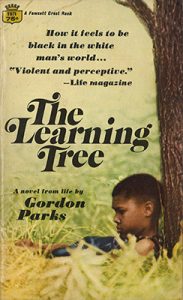
Writing Compilations
- Adoff, Arnold, ed. Black on Black: Commentaries by Black Americans. Collier, 1970. [Hall Collection E185.5 .B535 1970]
- Pieces and excerpts from Frederick Douglass, W. E. B. Du Bois, Walter White, Langston Hughes, Richard Wright, Ted Poston, Gordon Parks, Loften Mitchell, Ralph Ellison, James Baldwin, Lerone Bennett Jr., Dick Gregory, Bill Russell, John Oliver Killens, John A. Williams, Malcolm X, Ossie Davis, Martin Luther King Jr., Robert F. Williams, LeRoi Jones (Amiri Baraka), Stokely Carmichael (Kwame Ture) & Charles V. Hamilton, and Kenneth B. Clark
- Davis, Charles T., and Daniel Walden, eds. On Being Black: Writings by Afro-Americans from Frederick Douglass to the Present. Fawcett, 1970. [Hall Collection PS508 .N3 D3 1970]
- First Stirrings: pieces and excerpts from Frederick Douglass, Charles W. Chesnutt, Booker T. Washington, W. E. B. Du Bois, Paul Laurence Dunbar, James Weldon Johnson
- Coming of Age: pieces and excerpts from Alain Locke, Jean Toomer, Eric Walrond, Rudolph Fisher, Arna Bontemps, Langston Hughes, Claude McKay, Countee Cullen
- Early Moderns: pieces and excerpts from Richard Wright, Ralph Ellison, James Baldwin, Sterling A. Brown, Langston Hughes, Margaret Walker, Melvin B. Tolson, Owen Dodson
- Today and Tomorrow: pieces and excerpts from LeRoi Jones (Amiri Baraka), William Melvin Kelley, Eldridge Cleaver, Bayard Rustin, James Alan McPherson, David Henderson, Robert Hayden, Gwendolyn Brooks
- The Negro Problem: A Series of Articles by Representative American Negroes of Today. J. Pott & Co., 1903. [Alabama Collection E185.5 .N39]
- Booker T. Washington: “Industrial education for the Negro” — Du Bois, W. E. B.: “The talented tenth” — Charles W. Chesnutt: “The disfranchisement of the Negro” — W. H. Smith: “The Negro and the law” — H. T. Kealing: “The characteristics of the Negro people” — Paul Laurence Dunbar: “Representative American Negroes” — T. T. Fortune: “The Negro’s place in American life at the present day”
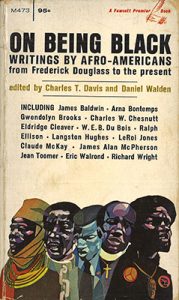
Black History by Black Scholars
This list is chronological.
- Wood, Norman Barton. The White Side of a Black Subject: A Vindication of the Afro-American Race: From the Landing of Slaves at St. Augustine, Florida, in 1565, to the Present Time. Chicago, 1897. [Rare Collection E185 .W87]
- Stanford, P. Thomas. The Tragedy of the Negro in America. A Condensed History of the Enslavement, Sufferings, Emancipation, Present Condition and Progress of the Negro Race in the United States of America. Boston, 1897. [Hall Collection E185 .S79]
- Kletzing, H. F. and W. H. Crogman. Progress of a Race, Or, the Remarkable Advancement of the American Negro: From the Bondage of Slavery, Ignorance and Poverty, to the Freedom of Citizenship, Intelligence, Affluence, Honor and Trust. Ferguson, 1900. [Hall Collection E185 .K642 1900b]
- Washington, Booker T. The Story of the Negro: The Rise of the Race from Slavery. Doubleday, Page, 1909. [Alabama Collection E185 .W316 1909 v.1-2]
- Scott, Emmett J. Scott’s Official History of the American Negro in the World War. Homewood Press, 1919. [Hall Collection D639.N4 S3]
- Du Bois, W. E. B. The Gift of Black Folk; the Negroes in the Making of America. Stratford, 1924. [Hall Collection E185 .D83]
- Wright, Richard, and Edwin Rosskam. 12 Million Black Voices; a Folk History of the Negro in the United States. Viking, 1941. [Alabama Collection E185.6 .W9]
- Woodson, Carter Godwin. Negro Makers of History. Associated Publishers, 1942. [Hall Collection E185 .W895 1942x]
- Redding, J. Saunders. The Lonesome Road: The Story of the Negro’s Part in America. Doubleday, 1958. [Crowley Collection E185.61 .R298]
- Bennett, Lerone, Jr. Before the Mayflower: A History of the Negro in America, 1619-1964. Penguin, 1966. [Hall Collection E185 .B4 1966a]
- Lincoln, C. Eric. The Negro Pilgrimage in America. Bantam Books, 1967. [Hall Collection E185 .L47]
- Quarles, Benjamin. The Negro in the Making of America. Collier Books, 1968. [Hall Collection E185 .Q2 1968]
- James, C. L. R. A History of Negro Revolt. Haskell House, 1969. [Hall Collection E185.61 .J16 1969]
- Toppin, Edgar Allan. A Biographical History of Blacks in America since 1528. McKay, 1971. [Hall Collection E185.96 .T66]
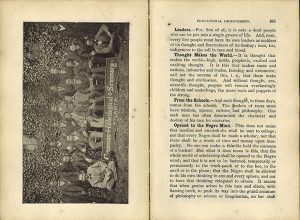
Civil Rights Movement
Note: The placement of an item or collection in this section doesn’t indicate the perspective of the creator, just that the piece is about the topic.
Books and Other Publications
- Alabama: the test of freedom. New York: N.A.A.C.P. Legal Defense and Educational Fund, 1965. [Alabama Collection KF4893 .A43 1965]
- Conference on the Deep South: ways and means to integration, Friday-Saturday, April 13-14, 1962. Alabama: , 1962. [Alabama Collection E185.92 .C66 1962]
- Aptheker, Herbert. Riding to freedom ; the new secession – and how to smash it. New York: New Century, 1961. [Alabama Collection E185.61 .A635 1961x]
- Burnham, Louis E. Smash the chains. New York: American Youth for Democracy, 1946. [Alabama Collection E185.61 .B958 1946]
- Clarke, Jacquelyne Johnson. These rights they seek ; a comparison of goals and techniques of local civil rights organizations. Washington D.C.: Public Affairs Press, 1962. [Alabama Collection E185.93 .A3 C55]
- Douglass, Frederick. Proceedings of the civil rights mass-meeting held at Lincoln Hall, October 22, 1883. Washington D.C.: C. P. Farrell, 1883. [Rare Collection E185.3 .D6 1883x]
- Handlin, Oscar. Fire-bell in the night: the crisis in civil rights. Boston: Little, Brown, 1964. [Hall Collection E185.61 .H23]
- Killian, Lewis M., and Charles M. Grigg. Racial crisis in America: leadership in conflict. Englewood Cliffs, NJ: Prentice-Hall, 1964. [Rare Collection E185.61 .K49]
- Lomax, Louis E. The negro revolt. New York: New American Library, 1963. [Hall Collection E185.61 .L668 1963x]
- Republican National Committee. To men and women who are tired of double-talk about civil rights .. and want a president who will give them action!. Washington D.C.: Republican National Committee, 1948. [Alabama Collection E748.D48 T6 1948x]
- Williams, Robert Franklin. Negroes with guns. New York: Marzani & Munsell, 1962. [Rare Collection F264.M75 W5]
- Young, Whitney M., Jr. To be equal . New York: McGraw-Hill, 1964. [Hall Collection E185.61 .Y73]
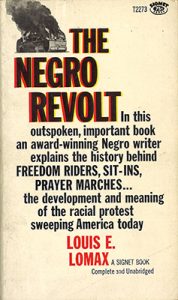
Oral History Audio and Collections
- Interview with Rev. Fred Shuttlesworth, 1984 (in Working Lives Oral History Project), accessible at http://purl.lib.ua.edu/54341
- Shuttlesworth was one of the central figures in the Civil Rights Movement.He discusses the role of the NAACP and churches, dealing with opposition from the Ku Klux Klan and Bull Connor, and the unwillingness of whites to speak up.
- Interview with Arthur Shores, 1984 (in Working Lives Oral History Project), accessible at http://purl.lib.ua.edu/54340
- Shores was an attorney involved in the Civil Rights struggle, including helping Autherine Lucy gain admittance to the University of Alabama in 1956.
- Dittmer, John. Local People: The Struggle for Civil Rights in Mississippi. University of Illinois Press, 1994. [Huie Collection E185.93.M6 D58 1994]
- Hampton, Henry. Voices of Freedom: An Oral History of the Civil Rights Movement from the 1950s through the 1980s. Bantam Books, 1990. [Hall Collection E185.61 .H224 1990]
- Huntley, Horace, and John W. McKerley. Foot Soldiers for Democracy: The Men, Women, and Children of the Birmingham Civil Rights Movement. University of Illinois Press, 2009. [Alabama Collection F334.B69 N438 2009]
- Williams, Juan. Eyes on the Prize: America’s Civil Rights Years, 1954-1965. Penguin, 1988. [Crowley Collection KF4757 .W52 1988]
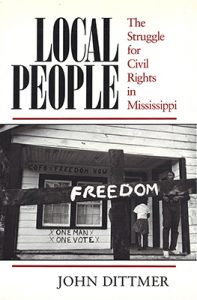
Artifacts and Ephemera
- Harry Belafonte and SNCC circular regarding Sammy Younge (MSS.2112)
- Birmingham NAACP “Freedom Train” Circular (MSS.2116)
- Report on Alabama Justice conference program, in A. S. Williams III Americana Collection’s small manuscript collections (W.0129)
- Mimeographed handout and schedule, Report on Alabama Justice, printed and distributed to attendees and participants of the Conference on Alabama Justice held at Tuskegee Institute on February 3, 1966.
- Selma marches broadsides (MSS.2113)
Movement & Countermovement
The John C. Payne papers (MSS.1114) are a collection of books, pamphlets, and other literature from civil rights groups, government commissions, and white supremacist organizations during the desegregation era.
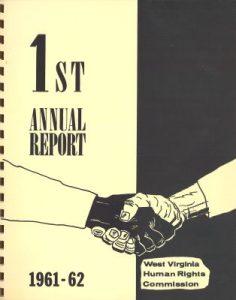
- Government reports on civil rights in various states
- Reports from the Tuskegee Institute, a Black institution of higher learning
- Pamphlets from the Citizens Council, a white supremacist organization, including their periodical, The Citizen (Oct. 1961-Mar. 1968).
- Reports and pamphlets from the Southern Regional Council, a majority-white reform organization promoting racial equality
- Pamphlets from the United States Commission on Civil Rights, including its periodical Civil Rights Digest
White Supremacy and Segregationism
Note: The placement of an item or collection in this section doesn’t indicate the perspective of the creator, just that the piece is about the topic.
Books and Other Publications
- Birmingham Committee to Preserve the American Republic. Every vote for the Civil Rights Act of 1963 is a nail for the coffin of the American republic. Birmingham, AL: Birmingham Committee to Preserve the American Republic, 1963. [Alabama Collection KF4756 .E93 1963x]
- Edwards, Lee, and Terry Catchpole. Behind the civil rights mask . Independence Press, 1965. [Hall Collection JC599 .E38 1965x]
- Evans, H. W. Is the Ku Klux Klan constructive or destructive? Haldeman-Julius Co., 1924. [Alabama Collection HS2330.K63 E934 1924]
- Evins, R. B. White supremacy endangered!: the South must continue democratic to avoid legislation to enforce the 15th Amendment. Jefferson Co. Democratic Campaign Committee, 1928. [Alabama Collection E185.61 .E93 1928]
- Haldeman-Julius, E. K. K. K.; the kreed of the klansmen. Haldeman-Julius Co., 1924. [Alabama Collection HS2330.K63 H3]
- Knowland, William F., John G. Crommelin, and John O. Beaty. Civil rights & secret police. How supreme is the Supreme Court? America entering police state?. 1957. [Alabama Collection E185.61 .C58 1957x]
- Ku Klux Klan. Constitution and laws of the Knights of the Ku Klux Klan (incorporated). Knights of the Ku Klux Klan, 1921. [Hall Collection HS2330.K6 A5 1921ax]
- —. The practice of Klanishness. Ku Klux Press, 1918. [Rare Collection HS2330.K63 K87 1918]
- Ku Klux Klan secrets exposed : attitude toward Jews, Catholics, foreigners, and Masons : fraudulent methods used, atrocities committed in name of order. E. A. Cook, 1922. [Rare Collection HS2330.K63 K9]
- National Committee for the Defense of Civil Rights in Tampa (U.S.). Tampa — tar and terror. National Committee for the Defense of Civil Rights in Tampa, 1935. [Rare Collection HS2330.K63 N38 1935]
- Walters, Robert J. As the pendulum swings ..: a study of the radical trend in the civil rights movement. Los Angeles, 1965. [Alabama Collection JC599 .W35]
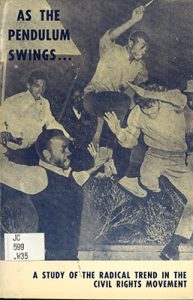
Artifacts and Ephemera
- Ku Klux Klan songbook (in Wade Hall Collection of Materials from White Supremacist Groups, MSS.4276)
- Folder of typewritten lyrics to thirteen Klan songs, based on popular, patriotic, and religious songs, originating from Danville, Kentucky.
- R. L. Hanvey collection (MSS.0624)
- A copy of the handbook Kloran (5th ed.), a leather wallet with the Klan seal, and a group photo of unidentified Ku Klux Klan women, belonging to a member in Birmingham, Alabama.
- Women of the Ku Klux Klan Collection (in Wade Hall Collection of Materials from White Supremacist Groups, MSS.4276)
- Letters, receipts, and robe order forms from the Women of the KKK of Michigan.
- Ku Klux Klan Pamphlet (MSS.3892)
- Pamphlet containing the names of Tuscaloosa, Alabama, residents who “signed the petition sent to Governor [George] Wallace,” presumably regarding the integration of the University of Alabama in 1963, and the names of the employers of the signers, illustrated with cartoons and with photos of James Hood and Vivian Malone.